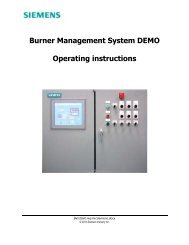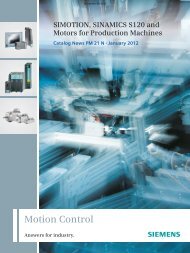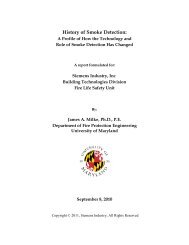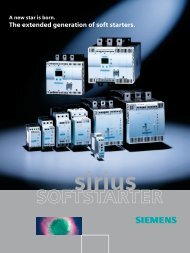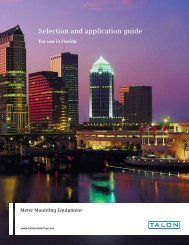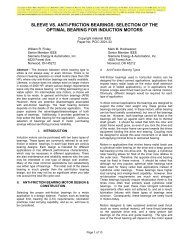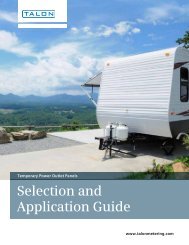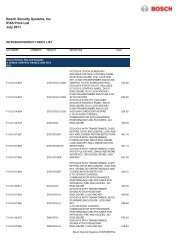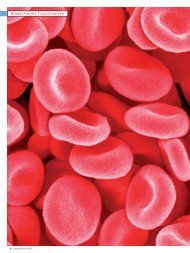Olympic Runners with Sinumerik and ShopMill Olympic Runners ...
Olympic Runners with Sinumerik and ShopMill Olympic Runners ...
Olympic Runners with Sinumerik and ShopMill Olympic Runners ...
Create successful ePaper yourself
Turn your PDF publications into a flip-book with our unique Google optimized e-Paper software.
13<br />
New concepts from the machine<br />
tool world<br />
The “wind makers” of TAO Technologies<br />
managed to find a solution in cooperation<br />
<strong>with</strong> PKsystems (former employees of the<br />
ZFS, the center for manufacturing technology<br />
in Stuttgart which accompanied the<br />
project). Together, a parallel kinematic<br />
mechanism was developed, the so-called<br />
Model Positioning Mechanism, or MPM<br />
for short.<br />
The MPM kinematic mechanism also<br />
consists of one Stewart platform, which is<br />
connected to the wind tunnel via six rigid<br />
bars <strong>and</strong> six carriages positioned on two<br />
parallel guide rails. Given the fact that it is<br />
difficult to distinguish natural oscillations<br />
from the aerodynamic effects when evaluating<br />
the dynamic forces <strong>and</strong> torques, linear<br />
motors are employed to move the carriages.<br />
First choice: linear motors<br />
from Siemens<br />
Six Simodrive 1FN3 linear motors from Siemens<br />
form the heart of the MPM<br />
1FN3 linear motors from Siemens were<br />
the first choice when selecting the drives,<br />
which are also popular at the ZFS for parallel<br />
kinematic designs. The natural oscillations<br />
of the test facility now no longer<br />
pose a problem: “With the MPM, the motion<br />
is a good order of magnitude better than previously<br />
was the case <strong>with</strong> the hydraulics,”<br />
as Thomas Löser, project supervisor at<br />
DNW-NWB, confirms.<br />
Three carriages are mounted on one axle<br />
respectively. As a result of the two-guiderail<br />
configuration, the design requires fewer<br />
components, thus cutting costs. All of the<br />
carriages can be shifted independently of<br />
one other, enabling movements <strong>with</strong> six<br />
degrees of freedom, <strong>and</strong> providing a work<br />
space of 1,100 millimeters in the wind direction,<br />
300 millimeters laterally <strong>and</strong> 500<br />
millimeters in the lift direction.<br />
The design achieves accelerations of up<br />
to 2.5 g, <strong>with</strong> the rigidity remaining virtually<br />
constant throughout the entire work<br />
area, as well as angle settings <strong>with</strong> an accuracy<br />
of less than 0.005 degrees.<br />
Tailoring the coordinate transformation<br />
To allow the engineers at DNW to program<br />
the forms of aerodynamic motion in a<br />
Cartesian coordinate system <strong>with</strong> amplitude<br />
data, frequencies as well as freely definable<br />
axes of rotation, a <strong>Sinumerik</strong> 840D<br />
was selected to serve as a control platform<br />
to support the st<strong>and</strong>ard coordinate transformation.<br />
The OEM interface of the <strong>Sinumerik</strong><br />
840D enables the integration of the<br />
54 parameters needed for the kinematic description<br />
of the transformation into the<br />
control, which are incorporated into the NC<br />
core of the basic control using compile cycles.<br />
The operator interface was also configured<br />
according to test engineer designs.<br />
Safety first in the tunnel<br />
As a result of the fact that the masses set in<br />
motion, <strong>and</strong> thus the kinetic energy, are very<br />
extensive, <strong>and</strong> the model aircraft also very<br />
expensive, <strong>Sinumerik</strong> 840D is equipped<br />
<strong>with</strong> the Safety Integrated components to<br />
fulfill safety-relevant requirements, also<br />
enabling the safety-oriented functions of<br />
“safe speed,” “safe stop positions” <strong>and</strong> “integrated<br />
brake test.”<br />
The brake test is particularly essential,<br />
because there is no counterweight for the<br />
highly dynamic axles. At the high traversing<br />
speed of the utilized linear motors, this<br />
function enables the prompt signaling of<br />
safety-relevant errors in accordance <strong>with</strong><br />
category 3, thereby ensuring a high degree<br />
of protection for man, machine <strong>and</strong> last,<br />
but not least, also models. “We must always<br />
keep in mind that a highly sensitive strain<br />
gauge scale is built into the model <strong>and</strong> can<br />
be overloaded very easily. If control over the<br />
linear motors is lost, the weight scale could<br />
be damaged, which is valued at 100,000 euros,”<br />
Löser explains.<br />
Measurable success<br />
The test facility has been up <strong>and</strong> running<br />
since the end of 2004 <strong>with</strong>out any faults.<br />
Measurements, for example, on the new Airbus<br />
A380, have revealed that the expectations<br />
of DNW regarding positioning speed<br />
<strong>and</strong> accuracy have been completely fulfilled.<br />
With the help of the new dynamic<br />
MPM, it is now for the first time possible to<br />
realistically simulate flight maneuvers in a<br />
wind tunnel.<br />
<br />
More information:<br />
www.siemens.com/sinumerik<br />
E-mail: thomas.wissert@siemens.com<br />
motion world 1/2007



